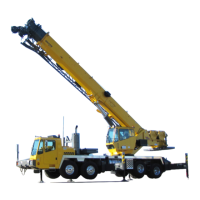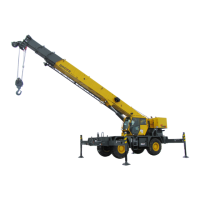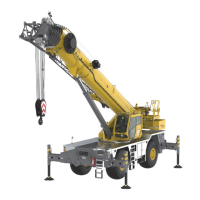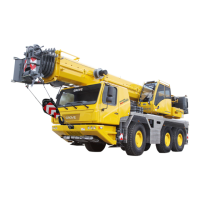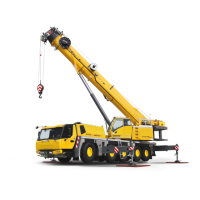OPERATING CONTROLS AND INDICATORS TMS9000-2 OPERATOR MANUAL
3-72 Published 02-21-2019, Control # 611-05
These switches are shown in a logical fashion based on their
function. The top row (S2110N, S2111N, and S2112N) is the
switches near the hydraulic actuator. S2111N is physically
located between S2110N and S2112N, so these indicators
are arranged in the same manner.
The next row (S2117N, S2118N, and S2116N) are indicators
for the tele cylinder being aligned with a boom section.
S2117N is shown to the left; when the tele cylinder is nearly
aligned (for instance within 50 mm or 2 inches of the
connection), and S2117N is ON, then the cylinder needs to
extend slightly (moving the right joystick to the right, if using
the standard joystick arrangement). If S2116N is ON in this
near connection condition, then the cylinder needs to retract
slightly (moving the previously mentioned joystick to the left).
These motions are logical with respect to what is shown on
the screen.
The remaining proximity switches, S2114N and S2115N, are
for the cylinder pins being retracted, so they are shown in a
column format to be logical with respect to their location on
the tele cylinder.
(Figure 3-65) has further explanation for the telescoping
emergency program screen. Item 1 is the graphical
representation of the tele cylinder pins that connect to a
telescoping boom section. When these cylinder pins are
considered retracted, an unlock symbol will appear in this
location.
Item 2 is the graphical representation of the boom section
and its pins that connect to the next telescoping boom
section. Note that in the telescoping emergency program;
the actual boom section is no longer able to be determined;
the crane operator must determine this. When these section
pins are considered retracted (at least the actuator has
moved to attempt this), an unlock symbol will appear in this
location.
Item 3 is the indicator for a command to attempt to retract the
cylinder pins. The arrow buttons on the display or the jog dial
can be used to highlight this, and hitting the OK/Enter button
will then attempt to execute the command. The lock/unlock
symbol on the button does not change based on the cylinder
operations (refer to Items 1 and 2).
Item 4 is the indicator for a command to release or re-extend
pins. This command works for both the cylinder pin retracting
and the section pin retracting; they are connected to the
same double-acting hydraulic actuation cylinder, so it can
only release the pins that had been previously retracted
(whichever they were). The arrow buttons on the display or
the jog dial can be used to highlight this, and hitting the OK/
Enter button will then attempt to execute the command. The
lock/unlock symbol on the button does not change based on
the cylinder operations (refer to Items 1 and 2).
Item 5 is the indicator for a command to attempt to retract the
section pins. The arrow buttons on the display or the jog dial
can be used to highlight this, and hitting the OK/Enter button
will then attempt to execute the command. The lock/unlock
symbol on the button does not change based on the cylinder
operations (refer to Items 1 and 2).
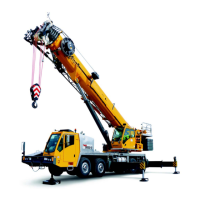
